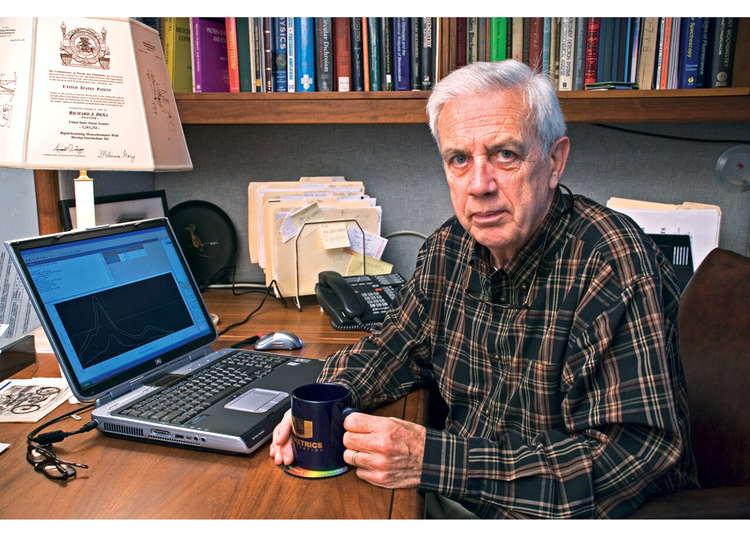The Buzz on Uv/vis/nir
Wiki Article
An Unbiased View of Spectrophotometers
Table of ContentsNot known Factual Statements About Circular Dichroism 8 Simple Techniques For Uv/vis/nirSome Ideas on Circularly Polarized Luminescence You Should KnowIndicators on Uv/vis You Should KnowThe Only Guide to Uv/vis/nir

Spectrophotometry is a tool that hinges on the quantitative analysis of molecules depending on how much light is absorbed by colored substances.
The Best Guide To Uv/vis/nir
A spectrophotometer is frequently utilized for the measurement of transmittance or reflectance of services, transparent or nontransparent solids, such as sleek glass, or gases. Lots of biochemicals are colored, as in, they soak up visible light and for that reason can be measured by colorimetric procedures, even colorless biochemicals can often be converted to colored substances appropriate for chromogenic color-forming reactions to yield compounds ideal for colorimetric analysis.: 65 However, they can likewise be designed to measure the diffusivity on any of the listed light varieties that usually cover around 2002500 nm utilizing various controls and calibrations.An example of an experiment in which spectrophotometry is used is the decision of the balance constant of a service. A certain chemical reaction within a solution might take place in a forward and reverse instructions, where reactants form items and products break down into reactants. At some point, this chemical reaction will reach a point of balance called a stability point.
10 Easy Facts About Circular Dichroism Shown
The amount of light that goes through the solution is a sign of the concentration of specific chemicals that do not allow light to travel through. The absorption of light is due to the interaction of light with the electronic and vibrational modes of particles. Each type of molecule has a specific set of energy levels associated with the makeup of its chemical bonds and nuclei and hence will soak up light of specific wavelengths, or energies, leading to special spectral residential or commercial properties.
The use of spectrophotometers spans different scientific fields, such as physics, products science, chemistry, biochemistry. circular dichroism, chemical engineering, and molecular biology. They are extensively used in lots of markets including semiconductors, laser and optical production, printing and forensic examination, in addition to in labs for the study of chemical compounds. Spectrophotometry is frequently used in measurements of enzyme activities, decisions of protein concentrations, decisions of enzymatic kinetic constants, and measurements of ligand binding reactions.: 65 Eventually, a spectrophotometer is able to determine, depending upon the control or calibration, what substances are present in a target and exactly just how much through estimations of observed wavelengths.
This would come as an option to the previously created spectrophotometers which were unable to absorb the ultraviolet correctly.
The Greatest Guide To Uv/vis
It would be found that this did not offer satisfactory results, therefore in Design B, there was a shift from a glass to a quartz prism which enabled much better absorbance outcomes - circularly polarized luminescence (https://www.startus.cc/company/olis-clarity). From there, Design C was born with a modification to the wavelength resolution which ended up having three systems of it producedIt was produced from 1941 to 1976 where the price for it in 1941 was US$723 (far-UV devices were an alternative at additional cost). In the words of Nobel chemistry laureate Bruce Merrifield, it was "probably the most crucial instrument ever developed towards the improvement of bioscience." Once it became terminated in 1976, Hewlett-Packard produced the first commercially readily available diode-array spectrophotometer in 1979 called the HP 8450A. It irradiates the sample with polychromatic light which the sample takes in depending upon its homes. Then it is transmitted back by grating the photodiode variety which identifies the wavelength area of the spectrum. Since then, the creation and execution of spectrophotometry devices has increased immensely and has actually become one of the most ingenious instruments of our time.

What Does Spectrophotometers Do?
The grating can either be movable or repaired.In such systems, the grating is repaired and the intensity of each wavelength of light is determined by a different detector in the variety. In addition, most contemporary mid-infrared spectrophotometers use a Fourier change technique to get the spectral info - https://pxhere.com/en/photographer/4182440. This technique is called Fourier transform infrared spectroscopy. When making transmission measurements, the spectrophotometer quantitatively compares the fraction of light that travels through a reference solution and a test service, then electronically compares the intensities of the two signals and computes the percentage of transmission of the sample compared to the referral requirement.

Report this wiki page